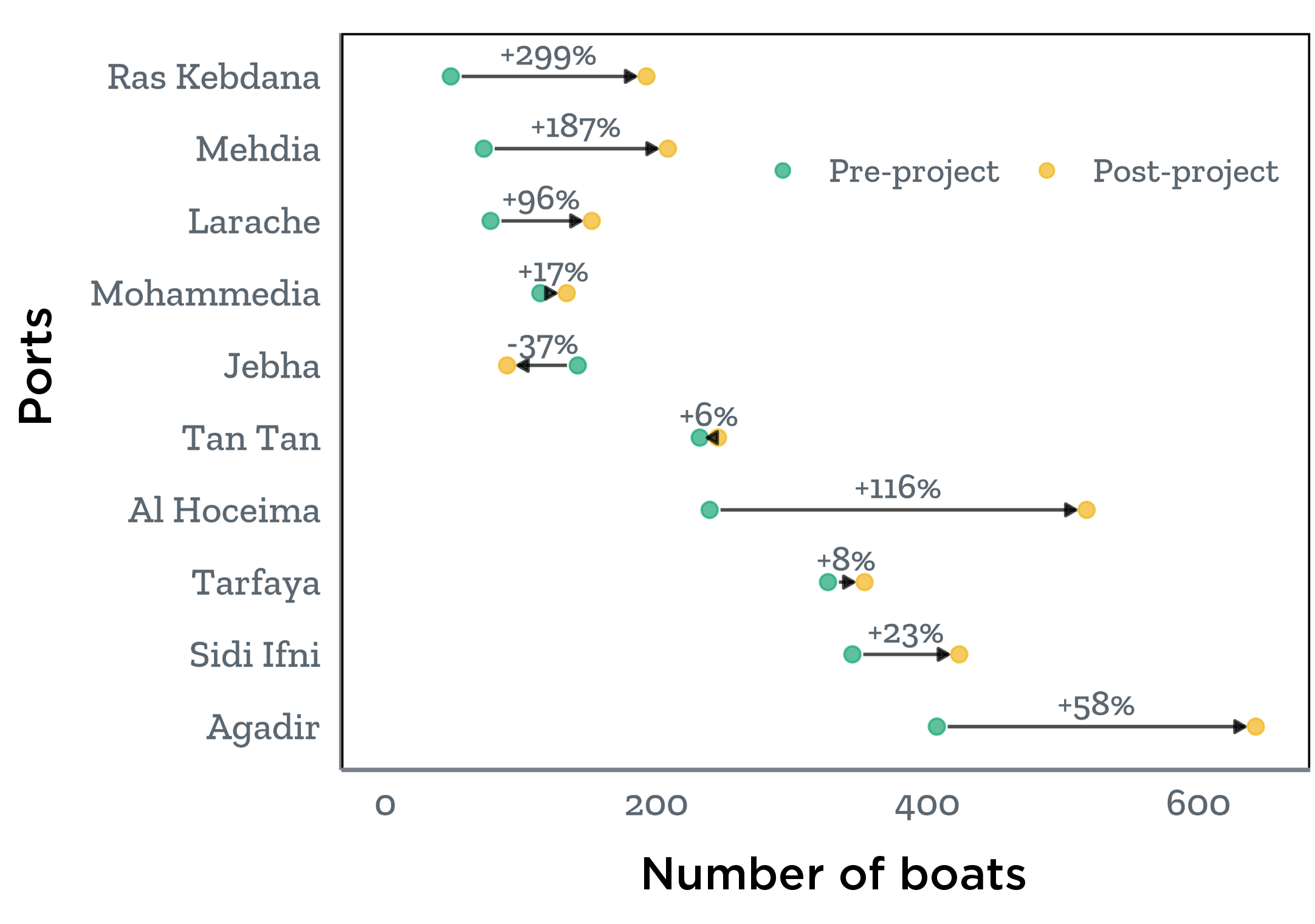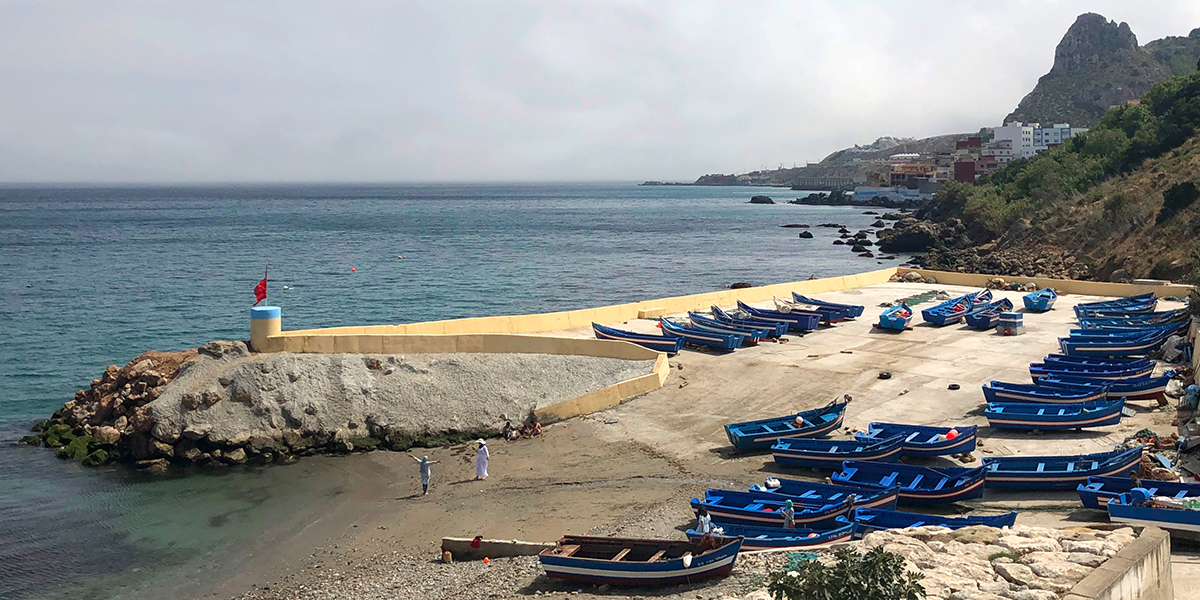Program Overview
MCC’s $650.1 million Morocco Compact (2008-2013) funded the $111.2 million Small-Scale Fisheries Project to improve fish quality, the value chain, market access, and sustainability by constructing or rehabilitating 10 fish landing sites, 10 port facilities, 3 marine protected areas (MPAs), and 5 wholesale fish markets. The project also provided training and technical assistance to fishers and staff at the facilities. The activities were based on the theory that improving fish quality, through better handling and cold chain management, and increasing access to markets would allow fishers to obtain higher revenues.
Key Findings
Fish Landing Sites and Port Facilities
- Construction and rehabilitation of sites occurred according to plan at most sites, but two sites are not fully operational.
- Fishing effort increased, but average daily catch did not and the project did not increase sales prices or fishers’ earnings relative to other fish sites in Morocco.
- Fishers and site staff believe quality increased due to improved handling and availability of ice.
Wholesale Fish Markets
- Construction occurred according to plan at most sites.
- The fish value-chain improved: respondents reported more vendors and buyers; a wider range of fish sources; improved fish variety and quality; and increased fish sales.
- Respondents believed that local fish consumption increased in all market cities.
- Market users reported the project created more jobs in the fish sector in project cities.
Marine Protected Areas
- Implementation went mostly according to plan, but due to delays, artificial reefs were only built in one of the three MPAs. This infrastructure was reportedly less useful than intended.
- Small-scale fishers who were aware of the regulations reported following them, but stakeholders reported coastal fishers were not.
Evaluation Questions
This final evaluation was designed to answer the evaluation questions summarized below:Overall
- 1 Were activities implemented according to plan?
Fish landing sites and port facilities activity
- 2 Are facilities properly built, well maintained, and functioning properly?
- 3 Has the number of fishers using the infrastructure increased?
- 4 What are the impacts on 1) fish quality, 2) fish prices, and 3) fishers’ earnings?
- 5 Have fishers adopted the techniques taught in the trainings?
- 6 What services do the professional organizations provide, and are fishers satisfied with them?
- 7 What are the impacts on national practices and institutions?
Wholesale fish markets activity
- 8 Has the volume of fish sold in the market cities increased?
- 9 Have consumer preferences for fish and fish consumption increased?
- 10 What are the impacts on the value chain, fish marketing, and job creation?
Marine protected areas sub-activity
- 11 What is the perceived state of the fish resources in the marine protected areas (MPAs)?
- 12 Do fishers and other actors follow the MPA rules of governance?
- 13 Has the activity influenced Morocco’s management of marine resources?
Detailed Findings
Fish Landing Sites and Port Facilities

Change in number of unique fishing boats by port
The total number of individual boats fishing at project sites increased since before the project. In some cases, the increase in boats exceeded projections. Total fishing effort—measured in the number of fishing days—also increased. Overall sales volume and average daily sales volume did not increase, but sales of higher-value species increased at project sites and across Morocco.
Average daily and monthly revenues increased for fishers at project sites, but revenue increases were similar among fishers more broadly in Morocco, so the evaluation cannot attribute any increases in revenue to the project.

Total sales volume per year, most common species categories
Wholesale Fish Markets
All markets were completed as designed, with some adjustments to the plans. While all markets had ice and cold rooms, ice production was not sufficient at a few locations and only one had a cold storage room that was below freezing at the time of assessment. Market users believe that fish quality improved due to the ice machines and cold rooms, hygiene practices, and regulations restricting the sale of poor-quality fish. Improvements in fish quality at project sites resulted in an overall increase in fish prices according to respondents. Staff, vendors, and buyers said the volume of fish sold at wholesale markets increased and that there are more and a wider variety of vendors and buyers, but market data were available only since the opening of the markets, so these claims cannot be verified with quantitative data. Market officials reported that fish consumers bought a greater quantity and variety of fish. According to senior officials and buyers, the project created jobs in the fish sector including wholesalers, fishmongers, and market support staff.Marine Protected Areas
Implementation went mostly according to plan, but artificial reefs were only built in one of the three MPAs due to implementation delays. Small-scale fishers aware of the MPA regulations reported following them, but stakeholders reported coastal fishers were not. Staff and fishers aware of the regulations, such as the prohibition against large fishing boats or the prohibition of certain types of fishing gear, reported regulations were not yet being enforced. The hotline for reporting infractions was established but used infrequently and the data recorded were not detailed. There were reported improvements in fish resource management and stakeholders reported marine health improved in the MPAs but data do not show differences in catch or revenues for sites near the MPAs compared with other sites.Economic Rate of Return
The CBA models for ports and fish landing sites found net benefits were negative, largely because the total number of boats was lower than the closeout CBA model predicted, boat-level revenues did not increase, and costs to fishers rose slightly. The ERR for the wholesale markets was 18 percent, exceeding the closeout ERR of 16.7 percent, because most markets opened and started accruing benefits before indicated in the closeout CBA.| Overall | Fish landing site | Ports | Wholesale markets | |
|---|---|---|---|---|
| Orignal ERR | 23.5% | 32.0% | 16.6% | 16.7% |
| Evaluation-based ERR | Undefined | Undefined - Net benefits were negative | Undefined - Net benefits were negative | 18.0% |
MCC Learning
- Economic models must account for the (likely low) market power of beneficiaries.
- Ensure causal pathways are realistic and achievable.
- During design, consider potential dependencies between outcomes.
- Consider possible consumer benefits such as food safety and nutrition.
- Reduce barriers to attend training programs.
- Prioritize robust measurement for fish quality.
Evaluation Methods
Time series analysis. The Fish Landing Sites and Port Facilities Activity combined high-frequency administrative and survey data to run a time-series regression model that accounted for annual and seasonal variation and included data from all fishing sites in Morocco to control for national catch and price trends.Pre-post analysis. For the Fish Landing Sites and Port Facilities Activity, the evaluation included a simple pre-post regression using baseline and endline fisher survey data.
Implementation study. For all activities, the qualitative analysis entailed processing raw audio data into transcripts, then reviewing, coding, and analyzing the transcribed interview and focus group data.
Infrastructure assessment. For the Fish Landing Sites and Port Facilities Activity and the Wholesale Fish Markets Activity, the evaluation presents descriptive statistics using infrastructure assessments and compares findings with project documentation.
2022-002-2745


